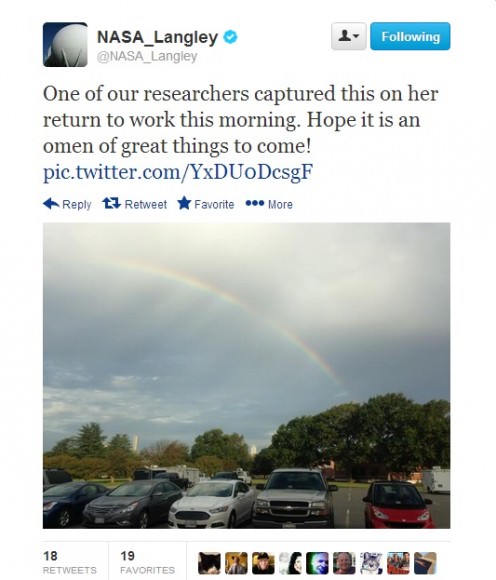After 16 days off the job, most employees at NASA returned to work today (Oct. 17). The good news came after a late-night deal by U.S. politicians to reopen government activities until Jan. 15 and raise the debt limit — originally expected to expire today — until Feb. 7. Democrats and Republicans were battling over the implementation of a new health care law; more details on how the deal was reached are available in this New York Times article.
During the shutdown, only mission-essential functions at NASA were completed except at areas such as the Jet Propulsion Laboratory, which are run by contractors. Twitter, Facebook and social media updates went silent. Missions were run on a needs-only basis, and for a while it looked as though the upcoming MAVEN mission to Mars might be delayed (although it got an exception due to its role as a communications relay for NASA’s rovers.)
So you can imagine the happiness on social media when NASA employees returned to work.

Given the length of the shutdown, not all work can just start immediately. Experiments have been left unattended for more than two weeks. Equipment needs to be powered back on. Cancelled meetings and travel arrangements need to, as it is possible, be rebooked.
At NASA’s Marshall Space Flight Center, spokesperson Don Amatore asked employees to be mindful of safety precautions, according to All Alabama. He also stated that “liberal leave” is in effect for employees today and on Friday, meaning that employees are able to take time off without requesting it beforehand — as long as their supervisors know.
Several Twitter reports from NASA contractors on Thursday also indicated that they were unsure if they would be coming back to work on that day, or at some point in the near future. The agency, however, was reportedly sending automated telephone updates to employees and contractors advising them to check with their supervisors for information.

The long-term effects of the shutdown are still coming to light. Certain NASA researchers who planned Antarctic work this year may lose their entire field season. Also, some researchers using NASA or government telescopes missed their “window” of telescope time. “SOFIA remains grounded as a testament to stupidity. Europa keeps her secrets,” wrote Mike Brown, a professor of planetary astronomy at the California Institute of Technology, on Twitter Oct. 13 about NASA’s Stratospheric Observatory for Infrared Astronomy.
Additionally, the S&P ratings agency noted that the U.S. economy lost $24 billion due to the shutdown, which is more than the initial $17.7 billion request for NASA’s budget in fiscal 2014. Given the agency is in the midst of budget negotiations and is worried about the viability of the commercial crew program, among other items, any long-term economic damage could hurt NASA for a while.
NASA and other government agencies also have only three months of relative stability until the government reaches another funding deadline. What do you think will happen next? Let us know in the comments.

